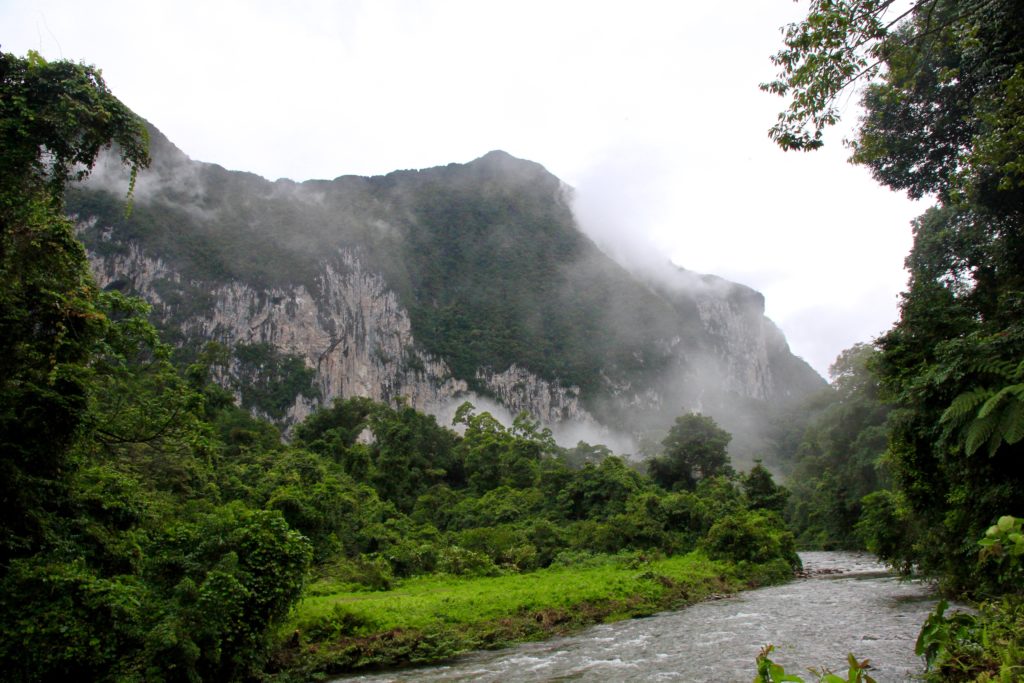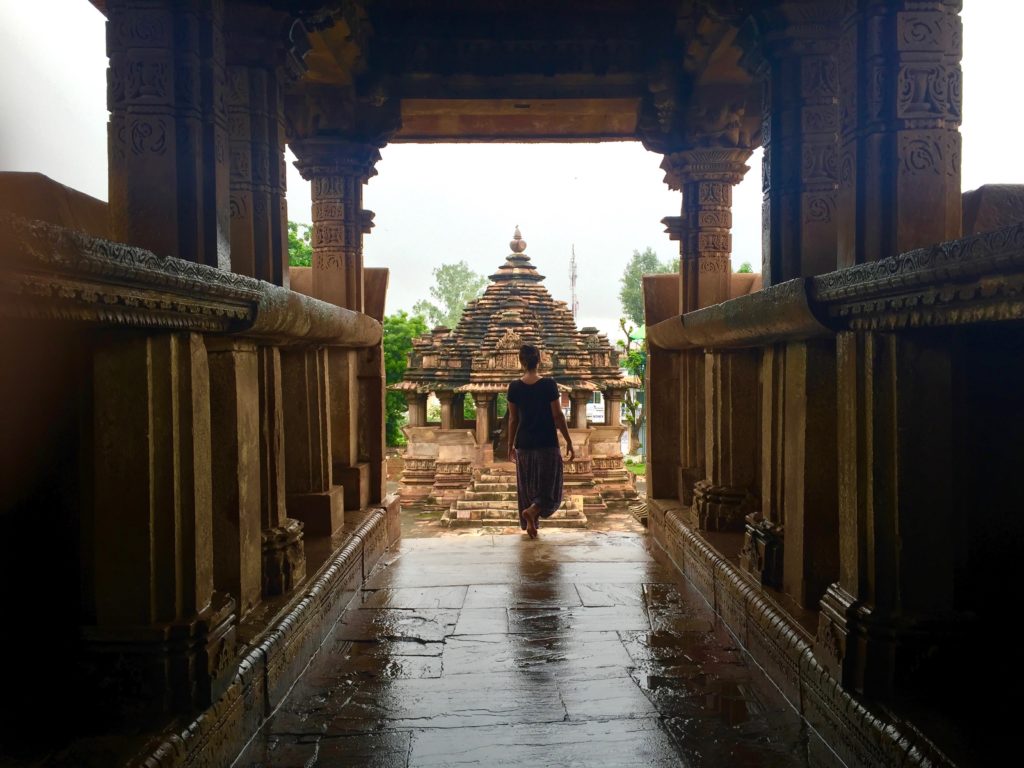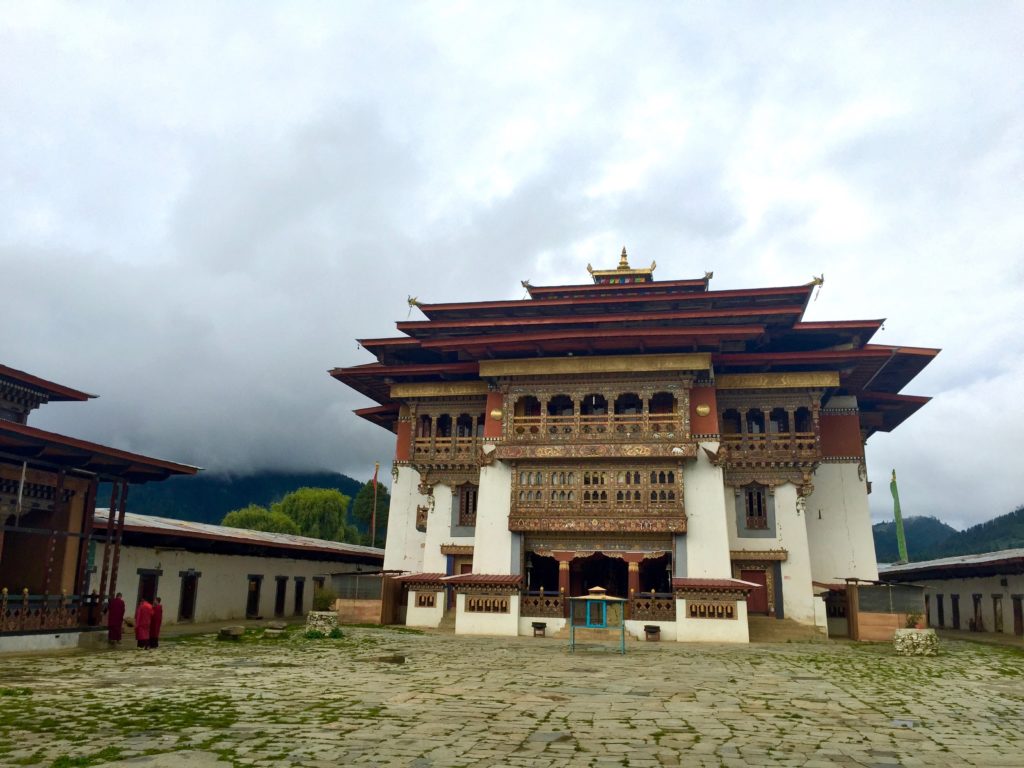Planning a Thailand island hopping itinerary for our family felt a little intimidating at first. Would it be too chaotic? Too much packing and unpacking? Too hard with kids in tow? But from the moment we stepped off the plane and into the thick, warm air scented with jasmine and grilled meat, I knew we were in for something special.
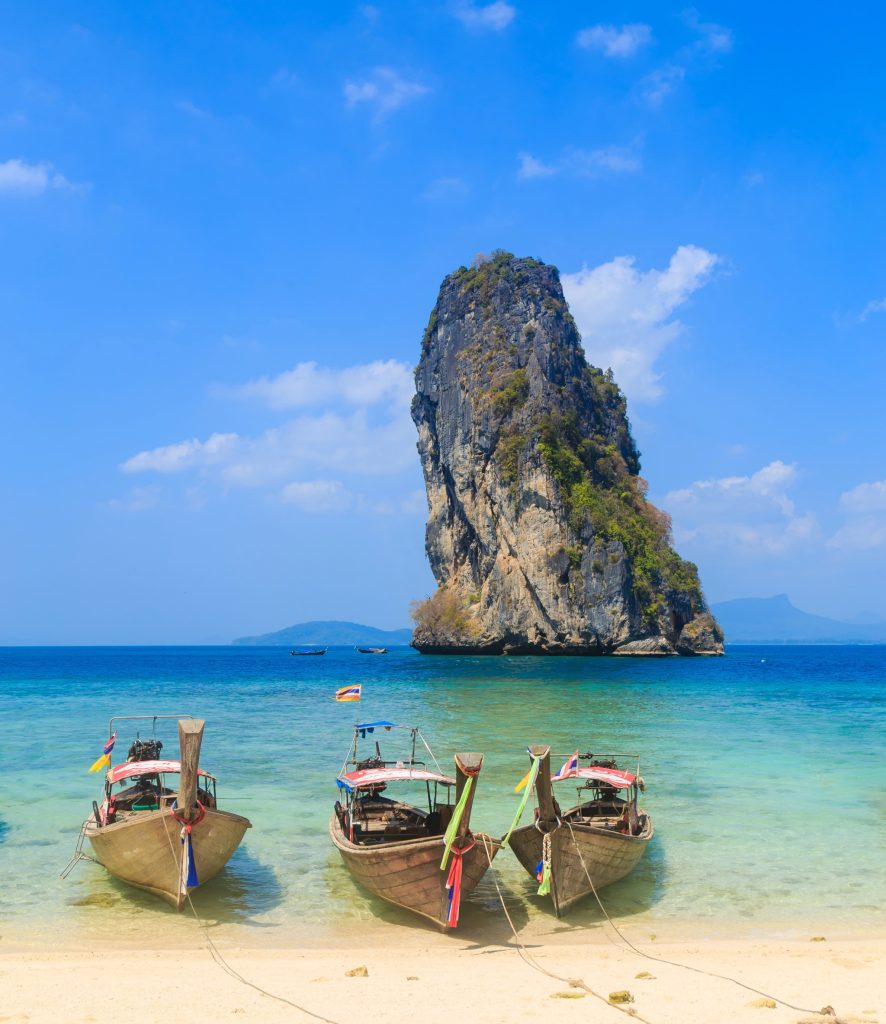
We spent ten days weaving through palm-dotted islands and ferry ports, where loudspeakers crackled in three languages and children ran barefoot past baskets of rambutans. On some islands, life moved slow—cicadas buzzing in the trees, hammocks strung under coconut palms, sand soft and almost too hot to touch. On others, the streets hummed with mopeds and sizzling woks, and night markets glowed with hanging lanterns and sticky-sweet desserts.
This wasn’t the kind of trip where everything is perfectly planned. And that’s exactly what made it so memorable.
If you’re dreaming of traveling through Thailand with kids, this guide walks you through a realistic, family-friendly route, one that balances comfort with just the right amount of adventure, blending popular highlights with quieter coastal spots where you can still fall asleep to the sound of waves. With plenty of family-friendly hotels in Bangkok, it’s also easy to recharge before continuing to the next leg of your journey. I’ll share where we went, how we traveled from one island to another (including ferry and car options), what worked beautifully, and what we’d skip next time.
Thailand has a rhythm all its own. And when you travel by island, that rhythm slows just enough for you to hear your kids laugh a little louder, breathe a little deeper, and maybe fall in love with travel in a whole new way.
Getting Around: How to Travel Between Islands in Thailand
Moving from one Thai island to another isn’t nearly as complicated as I thought it would be. In fact, transportation became part of the adventure—especially for the kids. You’ll find a mix of ferries, speedboats, and short flights connecting the islands, and each has its pros and cons depending on your budget, timeline, and comfort level.
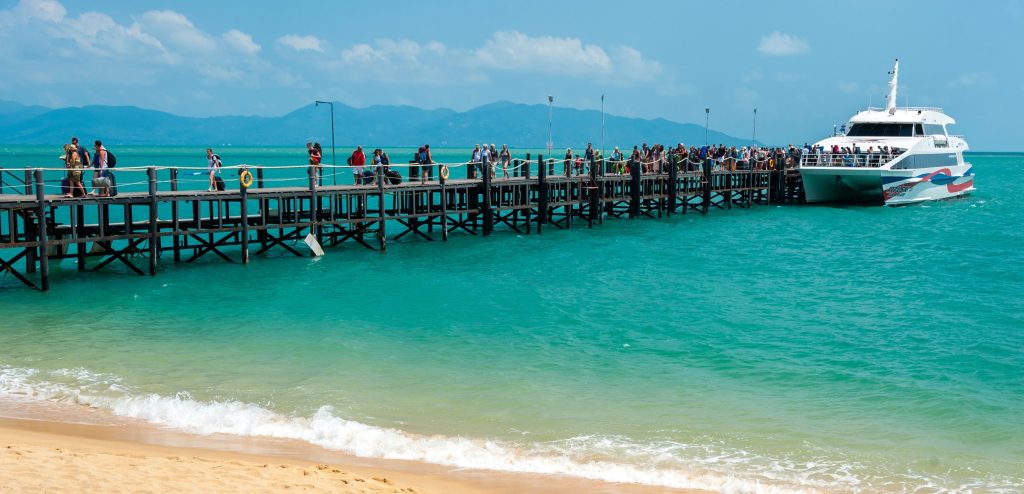
Ferries & Boats
Ferries are the most common and scenic way to island hop, and they’re surprisingly easy to book. The terminals are often buzzing with locals and travelers, the scent of grilled squid or instant noodles hanging in the air, and announcements echoing over speakers in Thai and English. The ride itself? It can be a breeze—or a bumpy adventure, depending on the weather and your route.
We traveled took a ferry from Lomprayah Koh Samui to Koh Tao, and it was by far the smoothest ferry experience we had. Their catamarans are faster, cleaner, and more organized than most we saw. We booked directly on their website, which made the whole process simple.
Travel Tip: Always bring motion sickness meds, especially if you’re traveling during rainy season or with kids who are sensitive to movement. The Gulf of Thailand can get choppy in the afternoons.
Should You Rent a Car in Thailand?
If you’re sticking to the islands, you might not need a car—but if your route includes places like Phuket, Krabi, or even day trips inland from coastal towns, renting a car is absolutely worth it. It gave us flexibility to explore quieter beaches, local markets, and little roadside noodle stalls you’d never find by sticking to the tourist areas.
We rented our car through DiscoverCars and picked it up right at the Phuket airport. The whole process was easy and affordable, and we were able to choose a compact SUV with enough space for luggage and snorkel gear.
Driving tip: Roads in touristy areas are in good shape, but be prepared for narrow shoulders, scooters zipping past on both sides, and occasional Google Maps confusion. Just go slow, and don’t be afraid to ask a vendor or tuk-tuk driver for directions—they’re often more helpful than GPS.
Day 1–3: Phuket or Krabi – Island Life + Easy Arrival
For most families starting a Thailand island hopping itinerary, the first stop is either Phuket or Krabi—both easy to reach by international flight and great jumping-off points for exploring the Andaman coast.
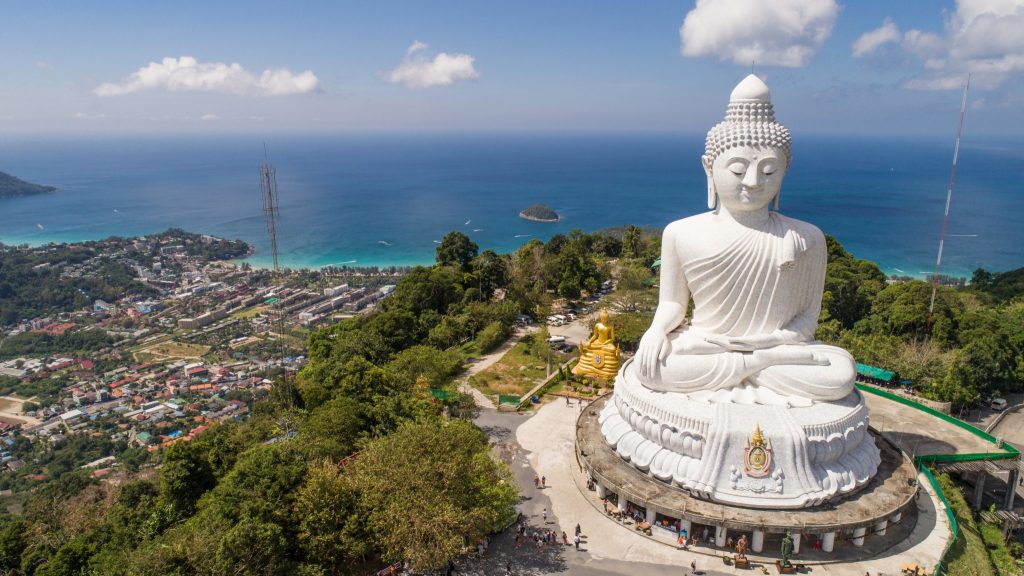
We chose Phuket as our entry point. The moment we stepped out of the airport, the air was thick with humidity and the scent of frangipani. Scooters wove past us in every direction, and the energy was instant. Phuket is busy, yes—but also incredibly convenient if you’re traveling with kids. It’s full of family-friendly resorts, soft-sand beaches, and easy access to supermarkets, restaurants, and clinics (a bonus when traveling with younger kids).
If you’re starting your island-hopping journey in Phuket, make time for a quick detour to see the Big Buddha. Sitting atop Nakkerd Hill, this 45-meter white marble statue is not only impressive in scale but also offers sweeping views over Chalong Bay. The quiet hum of bells, the scent of incense, and the fluttering of yellow flags give the space a peaceful, sacred energy—even if you’re just stopping by for the views and a few photos.

Another must-see while in Phuket is the Karon Viewpoint—a spot that rewards you with one of the most iconic panoramas on the island. From this elevated perch, you can take in the full curve of three dazzling beaches: Kata Noi, Kata, and Karon, stacked like brushstrokes along the Andaman Sea. It’s a breathtaking moment that puts your whole journey into perspective, and it’s especially striking at golden hour.

We stayed in the Kata Beach area, where the waves are gentle and there’s just enough going on to keep teens entertained without feeling overwhelmed. Sunset walks here were unforgettable—the golden light reflecting off longtail boats, the sound of waves folding in, and the smell of grilled chicken skewers floating over from a nearby food cart.
If you’d prefer something quieter to kick off your trip, Krabi might be the better option. Ao Nang is less hectic than Phuket but still offers stunning limestone cliffs, boat trips to Railay Beach, and a relaxed small-town vibe. From Krabi, you can hop on a ferry to Koh Phi Phi or even loop back around to the Gulf coast if you’re doing a wider circuit.
Unique Tip:
If you’re traveling with a child who struggles with overstimulation (like our daughter does), Krabi’s calmer pace can be a gentler introduction to Thailand. Fewer honking horns, fewer crowds, and more time to adjust to the climate, food, and language.
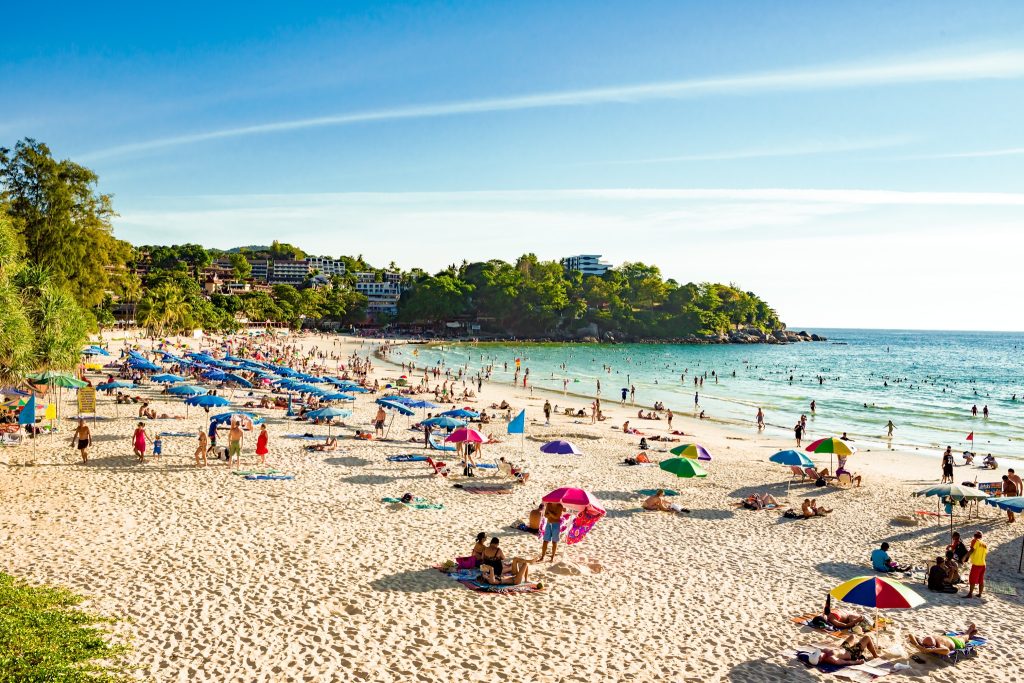
Day 4–6: Koh Samui – Relaxed Resort Life + Waterfalls
After a few days of beach town buzz, Koh Samui was exactly the shift we needed in our Thailand island hopping itinerary—a relaxing pause between more active stops.. From Krabi, we flew via a short domestic flight; from Phuket, you can fly or combine bus and ferry routes. Either way, once you arrive on Koh Samui, everything slows down.
The island has a gentler pace than Phuket and feels more spread out. Palm trees stretch along the coast, and golden Buddhas peek out from jungle hillsides. The air smelled like salt and ripe mango, and the resort we stayed at had a pool just steps from the beach—our kids were in it within five minutes of checking in.
What I appreciated most about Koh Samui was the variety: we could spend one morning visiting Na Muang Waterfalls, where the rocks are slick and red like clay and the pools at the base are cool and shaded, then head into Fisherman’s Village in the evening for dinner by the sea. Live music played softly from beach bars, and the fried banana pancakes from street vendors were a hit with all of us.
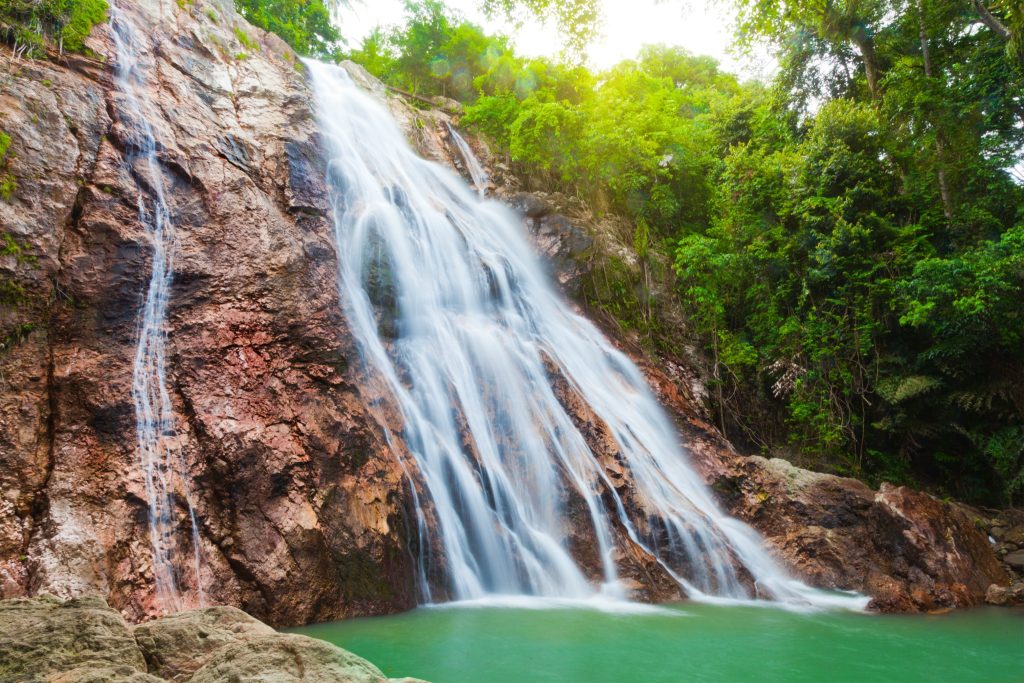
You don’t need a tight itinerary here. The island is easy to navigate, and whether you’re looking for temples, casual hikes, or just lazing by the ocean, it’s all accessible with minimal planning. We rented a car for a couple of days to explore the north and west sides of the island—quieter, less developed, and full of roadside coconut stands and small shrines wrapped in colorful cloth.
Getting to the Next Island
From here, it’s a short and scenic ferry ride to Koh Tao, one of our favorite stops on the trip. We booked our tickets through Lomprayah, which runs fast catamarans that are clean, comfortable, and efficient.
Travel Tip: Ferries from Koh Samui to Koh Tao fill up during peak season, so I recommend booking a day or two in advance—especially if you’re traveling with kids and want to guarantee seats together.
Day 7–9: Koh Tao – Snorkeling & Adventure for All Ages
Koh Tao marked a turning point in our Thailand island hopping itinerary, where the trip shifted from vacation to something closer to wonder. After the Lomprayah ferry ride from Koh Samui, which took just under two hours, we arrived at Mae Haad Pier to a different rhythm—slower, quieter, more barefoot.
The island is small—compact enough that it feels manageable with kids, but rich with things to do. The air smelled of sea salt and sunscreen, and within an hour of arriving, we were ankle-deep in crystal-clear water, watching schools of silvery fish dart past our feet.
Koh Tao is known for diving, but you don’t need to be scuba-certified to enjoy its underwater beauty. We spent a day at Ao Leuk Beach, a curved cove with gentle waves and colorful reefs just steps from shore. Our kids snorkeled for hours, spotting parrotfish and sea cucumbers while we relaxed under the shade of palm trees and sipped coconut water from the husk.
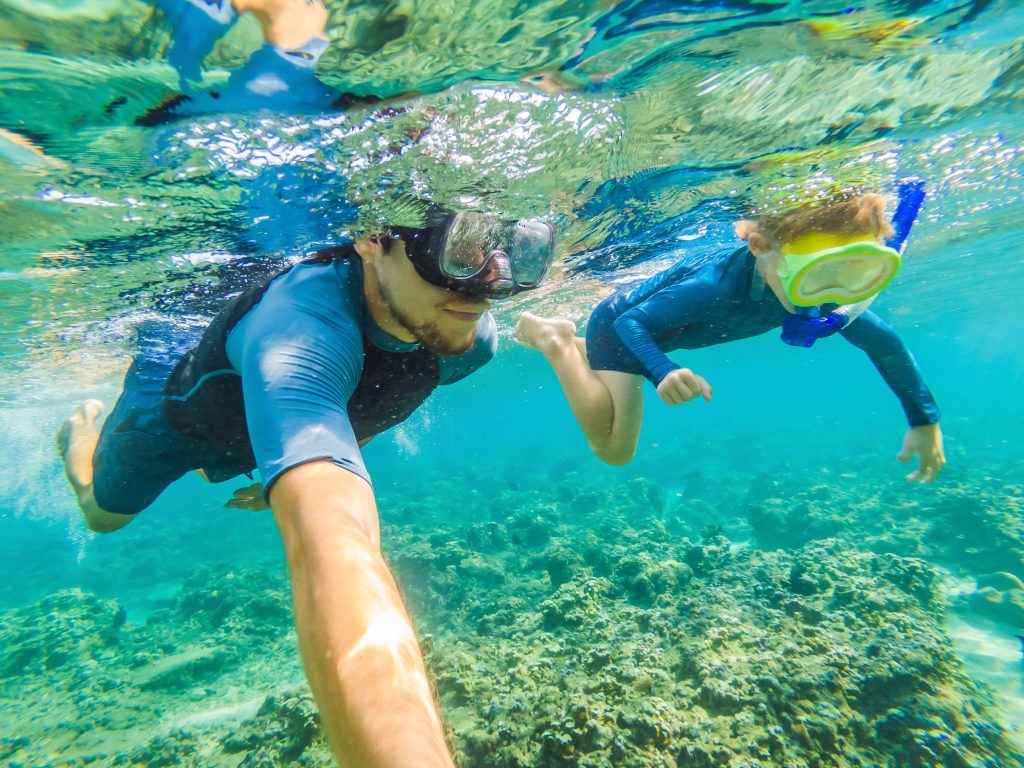
For families with older kids or adventurous teens, you can book a half-day boat tour around the island that stops at several snorkeling spots, including Shark Bay and Mango Bay. Most tours provide masks, fins, and life vests. Our guide even handed out slices of pineapple between stops—which somehow tasted better in the middle of the ocean.
We also took time to explore Koh Tao on foot, hiking up to the John-Suwan Viewpoint one morning. It’s a short but sweaty climb, especially in the heat, but the view at the top—lush jungle dropping into turquoise water—is one of those images that sticks with you.
Where We Stayed
We chose a small bungalow just south of Sairee Beach. Far enough from the nightlife to be quiet at night, but close enough for a walk to dinner. The room was simple but had everything we needed: fans, mosquito nets, and a hammock on the porch. And every morning, we woke up to the sound of geckos chirping and waves brushing against the shore.
Day 10: Return or Extend Your Trip
By the time day ten rolled around, we weren’t ready to leave. Koh Tao had slipped into our bones—our skin salty, our pace slower, our family rhythm finally syncing up with the islands.
From Koh Tao, the easiest way back is via ferry to Koh Samui, then a domestic flight to Bangkok or directly to your next international stop, depending on your airline. If you’re heading to northern Thailand (like Chiang Mai) or want to break up the journey, consider spending a night or two in Surat Thani or Bangkok before flying home.
But if your family’s energy is still up and your calendar allows it, this is the perfect point to extend the adventure. Many travelers continue on to Koh Phangan (just a short ferry from Koh Samui) for more beaches and nature hikes—or loop back to the Andaman coast for a totally different island vibe.
Alternate Routes & Flexibility
One of the things I loved most about this trip was how flexible it was. You don’t need to plan every detail in advance. You can adjust based on the weather, your kids’ moods, or even a conversation you have with a local who suggests a hidden beach or night market.
If we had a few more days, we would’ve hopped over to Koh Phangan—not for the parties, but for the quieter northern beaches and forest hikes. Families we met along the way raved about Bottle Beach and Than Sadet Waterfall.
Bonus Tips for Planning a Family Island Hopping Trip in Thailand
Whether you’re planning a two-week vacation or a shorter escape, a well-paced Thailand island hopping itinerary can make your trip feel effortless—especially when you’re traveling with kids. Here are a few things I wish I’d known before we went, along with what worked well for us.
Best Time to Go
Thailand’s dry season runs from November to April, which is the best time for island hopping, especially in the Gulf of Thailand (Koh Samui, Koh Tao, Koh Phangan). We traveled in early March and had mostly sunny days, though it was definitely hot—pack light clothing and sunscreen, and plan outdoor activities for early morning or late afternoon.
Avoid peak holiday seasons like Christmas and New Year if you’re hoping for quiet beaches or lower prices.

What to Pack (Especially with Kids or Teens)
- Quick-dry towels and swim shirts
- Reef-safe sunscreen (sold locally but more expensive)
- Waterproof dry bag for ferry rides and boat tours
- Basic medications: motion sickness, bug spray, rehydration salts
- Flip-flops and one pair of walking shoes or sandals with grip
- Reusable water bottles (refill stations are everywhere)
- Snacks for long travel days—some ferry rides have snack bars, others don’t
Booking Tips
-
Book ferries and domestic flights a few days in advance, especially during high season. Companies like Lomprayah allow online booking, which made things easier for us.
-
Accommodations on smaller islands (like Koh Tao) can book up quickly during peak travel months. If you’re traveling with a larger family or want a specific room type, book ahead.
-
Renting a car in larger locations like Phuket or Krabi gives you freedom and saves money on taxis or tours. We found great deals and flexibility with DiscoverCars—easy to book and pick up right at the airport.
Make Space for Downtime
One of the best parts of this trip wasn’t what we planned—it was the in-between moments. Reading in hammocks, watching monkeys steal fruit from market stalls, wandering beach paths without a schedule. If you try to squeeze in too much, you’ll miss the best part of island life: slowing down.
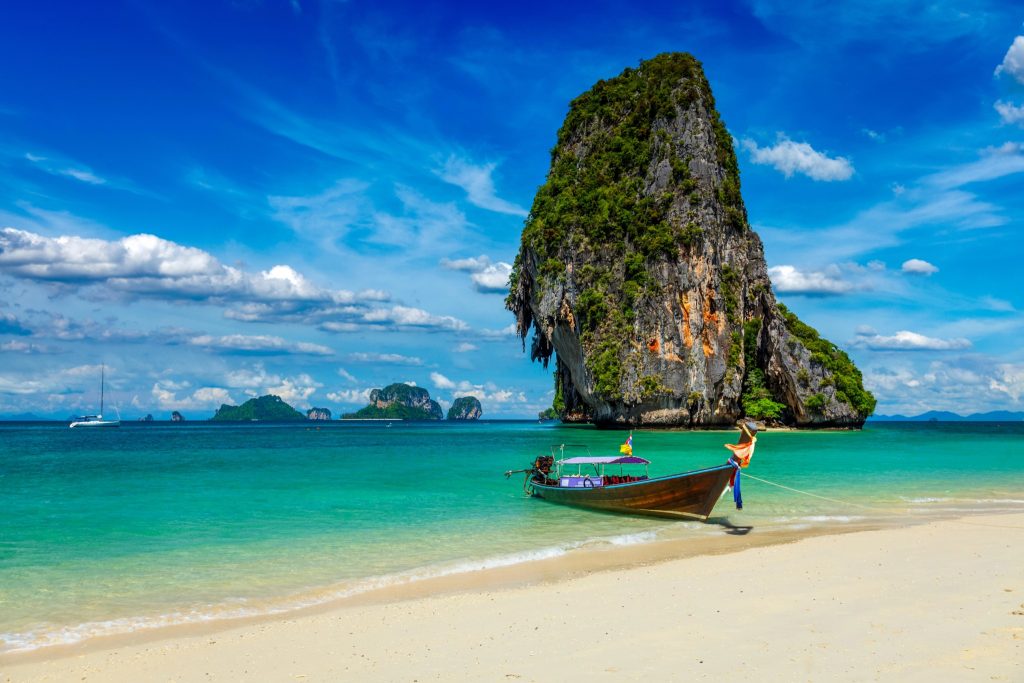
Your Thailand Island Hopping Adventure Awaits
If you’re looking for a trip that combines turquoise water, fresh mango sticky rice, and a pace that lets you actually breathe as a family, this Thailand island hopping itinerary delivers. It’s flexible, affordable, and filled with moments that feel both exciting and grounding—whether you’re snorkeling off the coast of Koh Tao or sharing pad thai under a string of paper lanterns.
Start small. Pick a couple of islands. Leave room for discovery. Whether you follow this exact Thailand island hopping itinerary or create your own version, what matters most is that you let the journey unfold with a little curiosity and a lot of sunscreen.
Traveling to Asia? Here Are Some Other Interesting Destinations Worth Adding To Your Bucket List
Quick Guide To Lush And Delicious Malaysia: 5 Reasons Why You Need To Visit This South East Asia Paradise!
- Moving to Canada as a Digital Nomad: A Safer, More Supportive Option for Families With Neurodiverse Kids - December 10, 2025
- Quema del Diablo in Antigua Guatemala: Dates, Schedule, and What To Know Before You Go - December 5, 2025
- La Quema del Diablo: The History and Meaning Behind Guatemala’s Burning of the Devil - December 4, 2025

